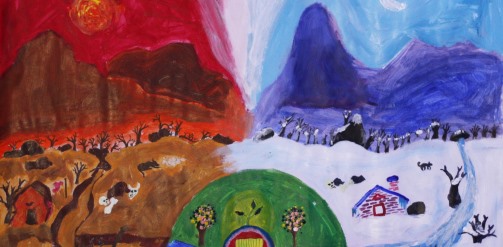Humanitarian crises rarely come without some kind of warning. On World Humanitarian Day, we are reminded in many places, there are people living on the precipice of crisis, in need of urgent support and help. Our rapidly changing climate is exacerbating many such crises, and it is in those crises that the most vulnerable that are set to suffer.

The recent Institute of Development Studies Bulletin, ‘Courting Catastrophe? Humanitarian Policy and Practice in a Changing Climate’, calls for humanitarian and climate adaptation policymakers and practitioners to link up to be able to prepare and respond to the threat of climate change and protect the most vulnerable in a much more considered and responsible way.
Reinforcing vulnerability?
Humanitarian crises represent a stark manifestation of human vulnerability to our changing climate. While, humanitarian actions deal directly with such vulnerability by alleviating suffering during crises, there is increasing realisation within the humanitarian sector that short term alleviation is not enough, because such measures often do little to address the causes of vulnerability, and sometimes even reinforce them.
A case in point, there are some food aid and development programmes in Nepal that have inadvertently legitimised unequal power relations in villages and encouraged the dependence of households on wealthier households for food. There is an urgent need, in climate change adaptation and humanitarian actions alike, for a deeper understanding of the context in which these actions are deployed, or risk entrenching power structures and the processes creating vulnerability in the first place.
New approaches within humanitarian aid provide opportunities for addressing vulnerability and inequities in the longer term, such as through building resilient livelihoods and social protection (cash transfer, food relief, public work programs, input subsidies, food subsidies, school feeding, crop and livestock insurance and grain reserves) and forecast-based financing mechanisms. Widening the scope of vulnerability assessments for example, could increase the understanding of humanitarian actions on vulnerability and development pathways.
Rethinking adaptation to climate change
However, it is increasingly clear that adaptation to climate change also requires a rethink. One where adaptation is not treated as a benign exercise that can benefit all, or simply an extension of the humanitarian principles of non-partisanship, but as a process that benefits different people very differently, creating winners and losers in the process.
Climate scientists increasingly argue that big and transformational change is required from fossil fuel intensive and inequitable development towards a more climate resilient future. A future that would ultimately combine mitigation of emissions, equitable development, and reduced vulnerability (pdf).
The change that is required is not about ‘us’ (donors, aid organisations, experts, privileged/less vulnerable) transforming ‘them’ (vulnerable groups) by forcing them to shift their livelihoods and practices. On the contrary, humanitarian aid illustrates how transformational adaptation starts with ‘ourselves’. Transformation is about making space for diverse groups to pushback and challenge inequitable power structures, decision making processes and development priorities that keep marginalising them. Fundamentally, it is about fostering the creativity inherent in ordinary vulnerable people’s decision making that can allow alternative, more sustainable approaches to emerge.
For such a shift to be possible, however, change is needed in the political and financial frameworks within which humanitarian actors work. Currently, rigid funding mechanisms and reporting requirements tend to reinforce a sector wise approaches to vulnerability reduction. The focus on measurable results also tends to favour technology type and short term ‘measurable’ actions rather than longer term vulnerability reduction.
Let the locals lead the way
Importantly, humanitarian action – even if effective at local vulnerability reduction – does not on its own constitute adaptation. It is only one of several types of actions in many spheres of societal development. The responsibility for climate change adaptation cannot be offloaded on neither humanitarian actors nor the recipients of humanitarian aid.
Nevertheless, humanitarian interventions will always impact and influence the prospects for transformational change, and because of that cannot be delinked from adaptation. It is by showing alternative ways of doing things locally, and how such alternatives can be supported, that the humanitarian system can and should be a driving force in creating adaptation. They could show the development and climate change communities how adaptation that lets vulnerable groups participate actively leads to a more sustainable and fairer future.